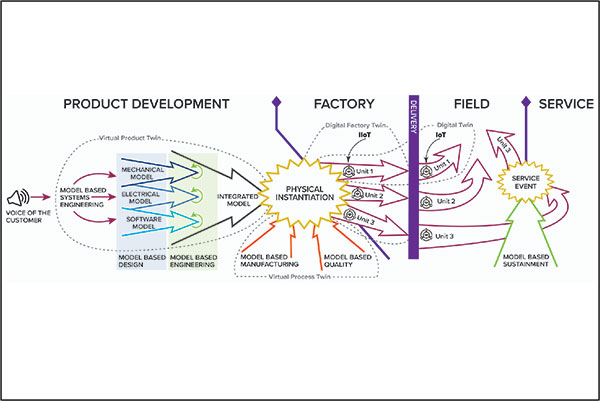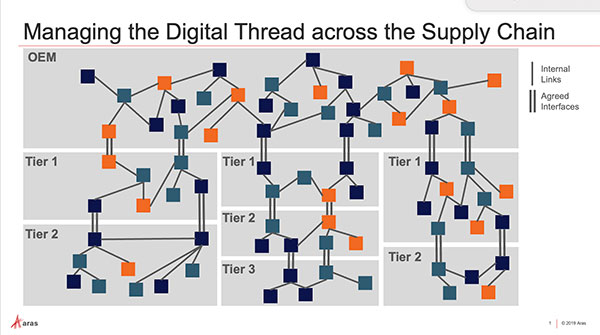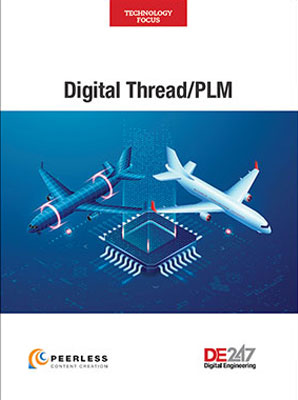A Digital Answer to Supply Chain Disruptions
Organizations must readjust how they run their supply chains to ensure smooth operations.

Risk mitigation and visibility enhancement require a greater awareness of the supply chain. All supply chain constituents must be able to access digital product data generated throughout the entire chain. Image courtesy of Razorleaf.
Latest News
October 27, 2022
Major market disruptions such as the pandemic, the war in the Ukraine and trade disputes have put enormous pressure on the structural weaknesses of traditional supply chains. These upheavals highlight the reality that even tried-and-tested supply chain management approaches previously successful can become obsolete overnight. Additionally, while the past few decades of globalization have made supply chains more cost-efficient, they have also made them brittle. Businesses steadfastly adhering to traditional practices now find themselves financially—and sometimes legally—vulnerable or worse.
To position themselves to better respond to market disruptions, companies are beginning to fundamentally change the way that they manage their supply chains—re-evaluating the basic tenets upon which they guide their operations, restructuring the material and component procurement process, and rethinking the way information is shared and accessed throughout all tiers of the supply chain.
Ultimately, a new type of supply chain implementation will determine success. These resilient and agile systems promise to ensure the consistent design and flow of goods by increasing the focus on risk mitigation (Fig. 1).
Risk Mitigation Takes Center Stage
Cost consciousness is deeply ingrained in traditional supply chain practices, yet lately the price of adhering to the principle has made many companies willing to consider new approaches. The single-minded pursuit to drive down costs has left supply chains fragile, and siloed functional optimization has led to suboptimal outcomes, improving one performance metric only to push the problem elsewhere.
“When the supply chain is more or less in equilibrium, the focus is on continuous optimization and cost reduction because risk is perceived to be low,” says John Kelley, vice president of product value chain strategy at Oracle. “So, inventories are run down, and just-in-time is seen as a good strategy, as is single sourcing. The result is an accumulation of risk. The pandemic discredited these assumptions and demonstrated that conditions change rapidly, exposing over-optimized, over-lean supply chains.”
To address these shortcomings, industry leaders advocate a new supply chain approach that encourages companies to pay less attention to achieving greater cost-savings and focus more on risk mitigation. Proponents of this approach contend that the result will be more agile and resilient supply chains.
Making this change, however, requires companies to acknowledge that resiliency requires more than a zero-sum game.
“Risk identification, mitigation and planning are key to avoiding or minimizing disruptions,” says Keith Zobott, global vice president of digital products and projects at SAP. “Companies should always have a backup plan and alternative sources of supply, as well as alternate designs and substitute components.”
A Fundamental Problem
One of the first steps companies must take to address these issues is to identify key problem areas. This process is complicated by the fact that no single factor is responsible for traditional supply chains’ obsolescence. Instead, a number of factors have come together to tip the scales.
Perhaps the biggest failing is the fragmentation and compartmentalization of traditional supply chains and the resulting lack of visibility.
“The fundamental reason why traditional supply chain management is inadequate to handle major disruptions is that systems, data and processes are inherently disconnected and siloed,” says John Lash, vice president of marketing at e2open. “Furthermore, most companies have outsourced the majority of their manufacturing, distribution and transportation to multiple tiers of external ecosystem partners, which are by definition outside of a brand owner’s control.”
This means they have lost visibility and the ability to manage or control processes across much of their extended supply chain, hamstringing decision-making.
“The traditional linear supply chain model allows only the parts of the supply chain immediately affected by a disruption to be aware of the problem, keeping parties further down the line in the dark until much later,” says Kelley. “This can result in differing lags between the demand signals in different supply chain tiers and can cause the so-called ‘bull-whip effect,’ where different tiers respond to out-of-phase signals that may be contradictory. This is particularly acute when both the frequency and amplitude of changes are high, such as was experienced in the pandemic.”
This fragmentation-induced blindness also hinders businesses from understanding the underlying cause of demand shifts and hampers efforts to determine whether an event is a short- or long-term issue.
Collaboration and Visibility Go Hand in Hand
The drive to reduce supply chain risks and to achieve greater visibility ties in closely with the need to achieve greater collaboration. Broadly speaking, risk mitigation and visibility enhancement require a greater awareness of the supply chain and an understanding of the interactions of the various parts.
Companies must recognize that risk isn’t only about the organization from which a company buys its raw materials or components. Supply chains consist of tiers that embody a large collection of players whose interactions have complex and long-reaching effects (Fig. 2).
The reality is that most demand disruptions come from beyond internal operations, and most supply disruptions start several tiers upstream. Therefore, to identify risks, companies must look beyond their immediate suppliers and monitor the entire length of the chain.
“Reducing risk starts with connecting the dots between cross-functional and cross-ecosystem processes and using real-time data, AI/ML and advanced analytics for end-to-end visibility, process orchestration and aligned decision-making across all parties in the supply chain,” says Lash. “This process spans across all core functional roles, from design to demand prediction, procurement, supply and manufacturing, allocation and fulfillment, distribution and service.”
With a deeper understanding of all the supply chains’ moving parts, manufacturers have an opportunity to monitor underlying economics and risk. It allows the ability to see a problem before it bubbles up, affording an opportunity to mitigate the situation before it is a crisis.
This, however, is easier said than done. With companies outsourcing most functions of their supply chain to organizations operating outside of their direct control, implementing communication and collaboration among internal and external systems and all relevant supply chain constituents is no easy task. It is essential if a company is to achieve the necessary supply chain resilience and transparency.
For example, to avoid new tariffs, a company may have to make design changes that require quick and efficient communication of engineering changes and manufacturing instructions to internal production, as well as to thousands of external contract manufacturers, to ensure compliance. This is simply not feasible with traditional supply chain practices.
A new approach and supporting toolsets are required.

Data elements spread across the supply chain can form a mesh of interconnected data, but visibility across tiers is limited (Panel A). Using a new supply chain management approach, a hyperconnected digital thread provides deep insight into related data throughout the extended supply chain (Panel B). The digital thread provides the information resources necessary to create a digital twin. Click here for a full-size image. Image courtesy of Aras
“Visibility into the entire supply chain enables companies to be one step ahead and more responsive to changes and disruptions,” says Rob McAveney, CTO at Aras. “Companies can achieve this with a software solution that provides a unified environment that allows all users of product information to collaborate around a single set of processes and data. In this situation, manufacturers and suppliers can trust that data is up to date and maintained in context. This accessible, contextual, actionable data is critical to continuously keeping pace with change.”
To find tools to help with this shift, companies now turn to technologies brought to the forefront by digitization initiatives—systems such as product lifecycle management (PLM) platforms, digital threads and digital twins.
“These technologies are the keys to connecting the myriad systems, data sources, and end-to-end processes to make plans based on what is actually happening in the supply chain instead of what you hope will happen, and responding to changes and disruptions in supply, demand, transportation and trade regulations,” says Lash.
A Single Source of Truth
To create a complete, accurate view of a supply chain, a company must integrate the entire product history and all related digital content across the supply chain into a digital thread, using platforms such as a PLM system.
This single source of data provides the critical foundation for an infrastructure that facilitates collaboration among all stakeholders and provides the means to model and simulate market scenarios and the impact of potential disruptions.
“When digital threads connect pieces of digital product data to each other, end-to-end analysis can be performed across combined views of data,” says Jonathan Scott, chief architect at Razorleaf. “For example, using country-of-origin data residing in PLM, coupled with delivery lead-time data on component specifications from an [enterprise resource planning (ERP)] system, allows a manufacturer to insert a four-week delay into their models to understand how a global shipping problem will impact their operations.
“Without manufacturing plans—found in PLM or manufacturing execution systems—connected into their digital thread, this calculation might have to be done based on statistics,” Scott continues. “With manufacturing plans connected to this detailed information, specific calculations can be done to analyze how individual subassemblies are impacted. Granular information like this will allow alternative sources of supply to be found to reduce the impact to operations. Without detailed information, the manufacturer might just delay delivery of its product based on statistical analysis.”
Thus, PLM and digital threads set the stage for companies to glean deeper insight into what suppliers are doing, bring suppliers into the processes earlier, and allow for deeper relationships. By making more information available about what suppliers are doing, digital threads help companies to safely navigate major disruptions and mitigate risk.
Extract Value from Visibility
Companies gain value from the supply chain’s digital thread by taking the data and weaving together a complete picture of relevant relationships, connections and decisions in the form of a digital twin.
“Having a holistic view of the product record—or digital thread—and how a product has performed enables digital twins to simulate and predict potential scenarios,” says Kelley. “For example, if you model supply risk across every bill of material and build a digital twin of that product's supply chain, you can simulate risk and disruption. For example, the 2011 earthquake in Japan closed a factory that was the only source for certain pigments used for black and red paint. Automakers were forced to not accept orders for specific colors until this was resolved. This single-sourced risk could have been easily modeled and simulated in a digital twin that evaluated supply risk for disruptions.”
Combine this visibility with new supply chain management concepts, and companies can move beyond the inherent limitations of traditional approaches and take risk mitigation to a new level.
“What’s missing in most supply chains today is the concept of systems thinking,” says McAveney. “Decisions are made early in a design process that shape the supply chain, and these choices are rarely revisited. There is usually more than one way to solve a design problem, but when a supply chain disruption occurs, we often focus on finding the same components somewhere else instead of seeking some other combination of parts to perform that function. Implementing systems thinking spread across the supply chain can lead to creative solutions that reduce cost and risk.”
More Aras Coverage
More Oracle Coverage
More Razorleaf Coverage
Subscribe to our FREE magazine, FREE email newsletters or both!
Latest News






